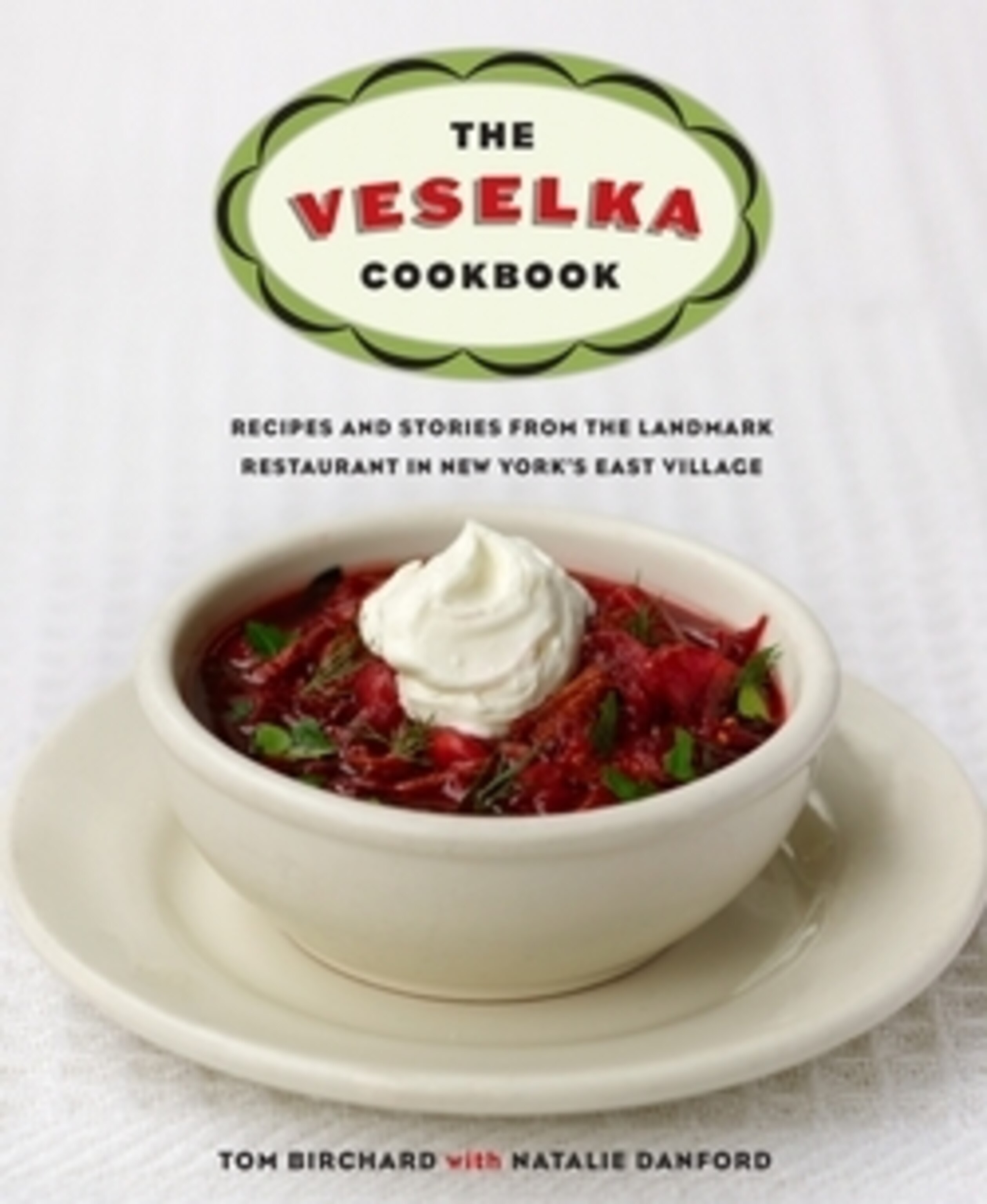
The Veselka Cookbook
For more than 55 years, the Veselka Diner has been a neighborhood institution in New York’s East Village, serving up its famous borscht and pierogi 24 hours a day to teenage hipsters, artists, college students, and celebrities like Chloë Sevingy, Jon Stewart, Julianne Moore and Sarah Jessica Parker. This week, the diner’s owner, Tom Birchard, released The Velselka Cookbook. Birchard worked with cookbook writer Natalie Danford to adapt the huge restaurant-style portions of 120 of their famous recipes for a more moderately-sized kitchen. (What? You don’t have a room for a vat full of borscht on your stovetop?) The book not only offers a glimpse into the kitchen, but provides lovely vignettes about the history of the restaurant and its role within the Little Ukraine neighborhood in New York City.
I spoke with Tom Birchard about pierogi, kitchen politics, and becoming an honorary Ukrainian.
Though you’ve been running the diner for 40 years, you’re actually not Ukrainian. How did you integrate yourself within the community?
When my father-in-law started the diner, he was a very patriotic and it became a gathering place for fellow Ukrainians. He sold periodicals and a limited menu of Old World foods that he loved. It became a Ukrainian hub.
Back when I took over, the community was still very isolated, tight-knit and somewhat distrustful of strangers. Their culture and language was under attack back in the homeland, so I wasn’t really accepted with open arms. It was an institution in the community, and this WASPy college kid was a bit of a threat to them. I didn’t really understand the language and the elder ladies kind of snubbed me. But in time, the younger generation got to know me and I’ve been adopted as honorary Ukrainian.

What inspired you to create a cookbook for the diner?
I’d seen other restaurants doing cookbooks and I’d thought about it for four or five years. I met a lady named Angela Miller, a very good cookbook agent, and she started gently prodding me to do a cookbook, half teasing, half serious. “Stop fooling around,” she said finally, and she introduced me to Natalie.
How did you select the recipes?
I knew that putting together the recipes would be very complicated. We produce a lot of things without recipes, and my staff are not generous when you ask them. We had some resistance. They had this Old World notion: Why would you publish our recipes? No one will come, they’ll all cook them at home.
Some of the things — borscht, pierogi, cabbage — are rather labor-intensive and the process isn’t that easy. But putting the cookbook together was not nearly as difficult as I imagined.
How did you convince your cooks to cooperate?
Natalie and I worked on the book for 18 months. Though I don’t spend a lot of time in the kitchen, we have some really good older Ukrainian and Polish cooks who love what they do and they put out a high-quality, consistent product. I’ve been looking over their shoulders the past 40 years, but Natalie gained their confidence. She was able to take their large recipes and break them down, taking an 80-gallon recipe for borscht and reworking it for an eight-person meal. She’d have them taste it and they got more involved. It was a fun project in the kitchen.
Veselka is considered an East Village institution. What are some of your favorite memories from the past 40 years?
When I first came here it was the Haight-Ashbury of the East Coast. Hippie artisans were selling leather goods and pottery — one guy made chess sets. It was a fun, nice place to be in the ’60s. That changed in the ’70s when the neighborhood was very drug-infested and dangerous. We almost went out of business; my employees were routinely mugged; we were held up many times. Many young people were addicted to heroin and ended up dying. In 1980 we got our first good review in the Village Voice – a review of our blintzes. That’s when things slowly began turning around – slow and steady.
On 9/11 when people were walking around dazed and shocked, a lot of people came here. We pride ourselves on staying open.
Veselka is more than a restaurant, you can come in and hang out, if you’re a little lonely, a little hungry, then we always try to be homey. We don’t pressure you to order more than a cup of coffee.
What’s your favorite dish?
- National Geographic Expeditions
I had pierogi yesterday and I hadn’t had them in a while. The pierogi are the consistent top staple food, they’re always a favorite. Blintzes and borscht are great, and the beef stroganoff, that’s really good.
Those are my favorite.
I love that you include notes about Ukrainian culture that you’ll find in neighborhood, including a walking tour of Little Ukraine. And the stories of some of the little old butchers that work across the street are adorable.
You can still find Ukrainian culture in this neighborhood. Surma has a lot of authentic Ukrainian things: pottery, publications, musical instruments. The Ukrainian Museum is on East 6th Street and has a collection of folkloric clothing, maps, ceramics and Easter eggs. The biggest Ukrainian church in the metro area is here – St. George Ukrainian Catholic Church, and many parishoners travel in from the suburbs every Sunday for Mass. There are still butchers here, and our diner is the East Village Meat Market’s biggest customer. Julian Bzczynsky, the butcher, is still going strong; they make a special-sized kielbasa just for us.
The Veselka Diner 144 2nd Ave, New York 10003, +1 212 228 9682
The Veselka Cookbook (Thomas Dunne Books, $27.99)
Photos: Thomas Dunne Books
